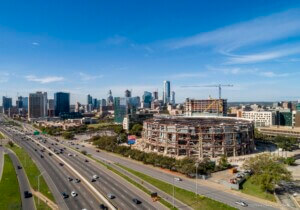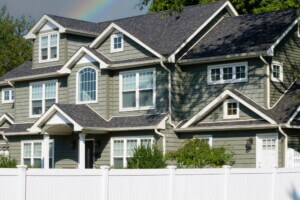In a teaser for the new season of IFC’s Portlandia, protagonist Fred Armisen comes to Austin, Texas whereKyle MacLachlan plays the mayor who navigates the pitfalls of our neighborhoods. Coffee shops, record stores, a couple of bars: “Alright, cool,” MacLachlan says. But then strollers and baby clothing stores start popping up, “Not cool!” he protests.
The show’s hyperbole isn’t far off: It’s hard to find a good, affordable place to live in this town.
The Austin real estate bubble’s most difficult issues manifest themselves in the realm of single-family housing. Buoyed by soaring property costs, speculative redevelopment has been transformative in central neighborhoods, especially East Austin. Typically, developers buy properties and quickly erect a cheap new house that maximizes the allotted FAR (floor area ratio) of the site, thereby maximizing sales profit. This type of development is disruptive. As houses grow larger and boxier, they change a street’s definitive qualities of scale and grain.
Last December, the Austin City Council updated the Accessory Dwelling Unit (ADU) requirements, which set limitations on the size and placement of back houses. ADUs are now able to be 1,100 square feet (up from 850 square feet), closer to the main structures (10 feet, down from 15 feet) and a parking space is not required in some areas. The minimum lot size required for an ADU is now 5,740 square feet, down from 7,000 square feet. The legislation also placed restrictions on the use of ADUs for short-term rentals, a contentious issue that further affects housing prices. This is a step in the right direction. Currently, Austin’s minimum buildable lot size is 5,750 square feet, and a movement for small lot amnesty calls for that number’s reduction. The opposition is explicit in its reasoning: Such a change would allow developers to buy larger lots and subdivide them, encouraging further conversion of neighborhoods into engines of capital creation. Unfortunately, whatever is good for urban density is good for developers, as it increases the number of housing units to be sold.
Small secondary houses do improve density, but they don’t adequately address affordability. Those residences are sold or rented at market cost-per-square-foot prices, rendering them only available to individuals or couples who can both afford them and only require so much space—youthful types who move here in large quantities. Hence, gentrification. This doesn’t help families or low-income individuals, populations that are in decline in central Austin. Minority residents of East Austin, for example, are priced out of their homes and are exiting the city in large numbers. African-Americans in particular are adversely affected, singled out as the only demographic that’s shrinking in our booming city. Such trends have created an Austin that is now the most economically segregated metro area in the country.
For Anthony Alofsin, AIA, a practicing architect and professor in architecture at the University of Texas at Austin, the concerns of diversity outweigh the concerns of density. Alofsin has been in Austin for almost 30 years, long enough to recount previous boom and bust cycles in the real estate market. Some of his academic research studies builder homes, which remain the most common way Americans house themselves, a statistic largely ignored by the architectural profession. In Alofsin’s view, a diverse mix of individuals—different patterns, passions, occupations, incomes, and ethnicities—leads to an “urban experience,” and Austin is short on this type of urbanity. Alofsin also worries about larger repercussions of civic housing trends: Changes in national family trends combined with the exodus of families from the city center spells disaster for the future of Austin’s public schools. Form-making isn’t important at this scale: Whether a house has a flat roof or fake stone or a turret is irrelevant to the economics at work.
To see what’s on the market now, Creede Fitch, a real estate agent with Skout who focuses solely on modern and midcentury properties, took me on a tour of neighborhoods near 12th Street. Close to the railroad tracks, one luxury spec house near the railroad tracks set a high water mark, selling for around $600,000 last year (it was also featured on the 2015 AIA Austin Homes Tour). A few blocks away, Fitch points out a slim lot with an older structure on-site, clearly not worth salvaging. “$290,000!” he reports, not without disbelief.
Fitch, who himself is building a new home in East Austin, tries to educate clients on both Austin and modern architecture, though he admits that “modern” is not important to many buyers. Fitch is also aware of better ways to increase density; he described one solution where smaller existing homes are maintained and a larger “primary” new build house is placed behind, providing privacy and preserving the scale of the street. A pilot project in this style is a casita renovated by architect Alan Gonzalez, sited on the front half of its lot. The steep price tag—a listed $375,000 for 785 square feet—would make most wince, but it’s a baby step in the right direction.
The good news is that some architects are working to change market realities, or at least their aesthetic dimensions. Jared Haas, principal of Un.Box Studio, spoke with me about a house he recently completed with Newcastle Homes. Knowing the market and the ground rules of spec projects, he designed a clean shape with a restrained material palette inside and out. Instead of the ubiquitous Hardie board siding, he sourced a vertical wood board at a comparable price. The house was purchased before it was completed, and Haas is at work on two more with the same company.
Other models of practice—architect-as-developer, design-build, design-build-develop—offer exciting alternate avenues of investment and engagement, and there are a number of successful examples at work in East Austin. Speculative building is now seen as pejorative, but it can be incredibly progressive. Haas, for one, looks forward to the time where spec projects, rather than further isolating residents, can bring them together in hybrid social spaces. What if speculative housing led the way toward new formats of living?
Later, I drove around East Austin to check in on its progress. I lived in the Chestnut neighborhood for two-and-a-half years in a full-size back house with two housemates; the house’s builder-developer had created a condominium complex of two houses on a single lot, another way to circumvent typical density limitations. It is both smartly dense, lucrative, and ruinous to the property values of neighbors. Nearby blocks are majority new builds, with accompanying new residents.
Construction has started on The Chicon, a three-building complex of affordable and market-rate apartments, close to an intersection that was once singled out as the city’s most dangerous. In 1925, one could take a streetcar from that corner all the way downtown. Now there’s a skee-ball bar on the block. Neighborhoods roll over, sometimes with unfortunate consequences, but the tide keeps going—part of life in a city. I stopped in front of a particularly ugly spec home with walls that bulge and tilt, as if frozen in nauseous mid-collapse. I slow my car to photograph the offense, but instead smile, wave, and move along—there is a moving truck out front with a couple unloading bicycles, ready to make that house their home.










